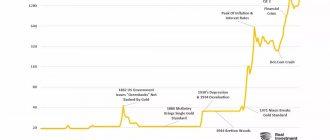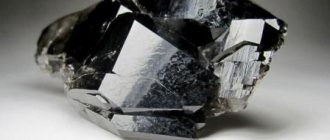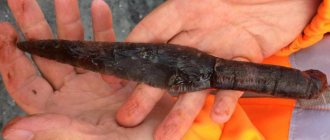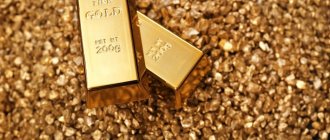Origin of gold on Igor Garshin’s website
Home
| Write |
Home > Natural Sciences > Earth Sciences > Geosphere Sciences > Gold Geology > Gold Formation
Alphabetical list of pages: | | | | | E (Yo) | | | | | | | | | | | | | | | | | | | | | | | | 0-9 | AZ (English)
| The process of origin of gold is still unknown to science. |
There are different versions of the origin of gold on Earth: meteorite, geonuclear, biogenic (see articles and news below).
Gold ore is a surface phenomenon, although gold is heavy and must have sunk into the core early in Earth's history. This means that the presence of gold in the lithosphere is of cosmic or biogenic origin [or somehow rose from the very depths].
To explain the origin of gold ores, geologists have created a hypothesis that is as beautiful as it is difficult to prove, according to which at great depths (tens of kilometers) hot, gas-saturated aqueous solutions are formed that have the ability to dissolve large amounts of gold. Squeezed into cracks under high lithostatic pressure, such solutions cool and crystallize at depths from hundreds of meters to several kilometers, releasing a useful component. [And this theory characterizes the “classical” geologists.]
Sections of the page about gold synthesis and metallogeny :
- Nuclear fusion of gold
- Biogenic accumulation of gold
- Metallogenic eras
- Geological epochs of gold formation [aurogenesis]
- Formation of gold deposits on Earth
- Articles on gold formation and gold forecasting
- News on gold metallogeny
Also see the geochronology page for information on supercontinents for each paleontological era.
Nuclear fusion of gold
Many heavy elements are synthesized in the interior of stars, but this is only true for atoms up to iron. Numerical modeling showed that gold, platinum
,
thorium
,
plutonium
and other heavy atoms are born during the merger of neutron stars. With such a merger, a portion of very hot matter weighing several Jupiters is thrown into space. When this plasma clot cools down to 10 billion degrees, nuclear reactions begin in it, creating superheavy atoms, and due to the decay of the latter, simply heavy ones like gold.
- Origin of gold. Gold
, as a chemical element, was formed during the collision of new stars. - Astrophysicists have explained the origin of gold in the Universe. Gold nuclei are formed during the nuclear decay of superheavy nuclei, and the latter - during the collision of neutron stars in a binary system.
Types of deposits
Deposits are divided into primary - post-magmatic - and secondary, formed as a result of the destruction of the first.
Indigenous
Ore deposits are localized on the surface of the earth's crust in places where molten magma came out (for example, during volcanic eruptions). Until the 20th century, they were poorly developed, because the extraction of gold from rock is labor-intensive and ineffective without technical means. But in the 20th century, humanity took revenge and in a hundred years produced the same amount of gold as thousands of years before.
Alluvial
Placers of gold - concentrate - are found mainly in alluvium ("alluvium" - deposits formed by water flows). It is interesting that sometimes alluvial deposits are found in places hundreds of kilometers away from the original ones. After washing, spot gold (“rough”) gold is chemically purified.
Metallogenic eras
Before considering aurogenic epochs, let's look at the epochs of general metallogenesis (age is given in million years):
- Vendian
(570-610) [close zircon peaks: 142, 300, 370, 425, 642]. Then a pause of about 400 million years [until the end of the Mesozoic and the beginning of the Cenozoic?]. - Middle Riphean
(1000-1350) [zircon peaks: 920, 1100, 1250]. - Early Riphean
(1350-1650) [zircon peaks: 1550]. - Svecofennian
(1650-2100): Svecofennian (
Vepsian
: 1650-1800) [zircon peaks: 1750]. - Svecofennian ( Calevian
: 1800-1920) [zircon peaks: 1950]. - Svecofennian ( Ludicovian
: 1920-2100) [zircon peaks: 2130].
(2400-2500). Before this there is a pause of 300 million years.
(2500-2800) [zircon peaks: 2650 (middle), 2730].
(2800-3000) [zircon peaks: 2900 (middle)].
At Voitekhovskaya
a number of gold mining epochs are noted, among which
the Late Archean
(2.9-2.6 billion years ago) [Late Lopian era], represented by deposits of
the Witwatersrand
(South Africa),
Kalgoorlie
(Western Australia),
Hemlo
,
Yellowknife
, and characterized by the widespread development of active volcanic and post-volcanic processes, stands out .
This is followed by maxima of 1.7-1.6 [end of Svecofennian], 0.8, 0.4-0.24 and 0.2-0.01 billion years ago. The Paleozoic
and
Meso-Cenozoic
maximums mean a new activation of the gold mining process. Moreover, the periodicity of gold mineralization maxima approaches the periodicity of orogenic endings in the tectonic history of the Earth.
Geological epochs of gold formation
It turned out that the distribution of deposits in geological time has a pronounced discrete nature. The emergence of the most significant gold deposits is associated with certain stages in the development of the Earth, and they are confined to geological formations of a special type. [Let us consider these aurogenic epochs against the background of general metallogenic ones.]
- 3.8-2.8 billion years ago, ore formation began on Earth. This was the Archean [lower and middle Archean] metallogenic era, covering the era of the proto-continent Vaalbara. Giant gold deposits of the most ancient shields were formed: Porcupine, Kirkland Lake
- on the Canadian Shield;
Kalgoorlie
and others - in Western Australian;
Kolar Goldfields
- in Hindustan;
ore fields of Western and Southern Africa. In all these deposits, gold is contained in thick quartz veins. The deposits of this era are very unique and in many ways unlike younger ones. Thus, the Yellowknife
(translated from English as the Yellow Knife) is represented by a suite of ore veins up to 4 km long, with consistently high metal contents. And the largest, continuously mined vein of the Kirkland Lake deposit was traced for 2 km. But, perhaps, the most characteristic is the stable high vertical gold content, due to which the mining depth of many deposits exceeded 2000 m, and at the unique Witwatersrand deposit in South Africa reached 3.5 km [already 5!]. - 3.2-2.5 billion years ago, the richest deposit on our planet was formed - the Witwatersrand
in South Africa. This orogeny also belongs to the Archean [Upper Archean - more precisely, Mesoarchean-Neoarchean] metallogenic era, coinciding with the era of the Kenorland proto-continent. - 2.5-1.9 billion years ago the Homestake gold deposits in the USA, Sukhoi Log in the Baikal region and the Boliden gold pyrite deposit in Sweden were formed. This geological process occurred in the Early Proterozoic metallogenic era, almost coinciding with the era of the Columbia continent.
- [Nothing is said about aurogenesis in the Middle Proterozoic (1.9-1.65 billion years ago - gold of Sudan), Early Riphean
(1.65-? billion years ago - Yakutia, Sudan) and
Late Riphean
(?-0.57 billion . years ago - massive development of copper sandstone deposits, manifestation of hydrothermal deposits of gold, copper, tin and tungsten) metallogenic eras.] - Almost 1.5 billion years [2 Willis cycles = 8 galactic years] lasted a geological pause in the formation of gold [with the exception of the Lower Paleozoic deposits of Southern Siberia - Eastern Kazakhstan], which was replaced by 400-250 million years ago [Upper Paleozoic: Devonian - Permian] bright and a very productive stage ( Caledonian
metallogenic era).
During this period, two powerful mountain belts emerged - East Australian
and
Ural-Mongolian
. Each of them is the richest gold mining province, from whose deposits thousands of tons of gold were extracted. - 250 million years ago [the end of the Paleozoic - Mesozoic] a new cycle of ore formation began ( the Hercynian
metallogenic era): folded belts grew around the Pacific Ocean depression and numerous gold deposits in Chukotka, Kolyma, Primorye and the Amur region. The Caledonian and Hercynian metallogenic epochs (as well as the Alpine epoch that replaced them) lie in the middle of the epoch of the proto-continent Pangea. - [It is also not said about the formation of gold in the next - Alpine
(50 million years ago - Cenozoic [Paleogene]) metallogenic era, when the gold deposits of Kamchatka, the Philippines and the Caribbean were formed.]
That is, in the geological history of the Earth there were 2 main episodes in the formation of gold deposits. The first covers the very initial stages of the Earth's development, and the second covers the last few hundred million years.
(Based on the article “Gold is a Mineral”)
Table element - gold
Aurum - gold - is one of the elements of the famous table of chemical elements, part of the group of metals. It is very resistant to various aggressive influences. Oxygen has absolutely no effect on this solar metal, so it does not oxidize. This metal is not exposed to various acids if the exposure occurs by one type. At a temperature of +25℃, the metal can dissolve in a mixture of nitric and sulfuric acid. Gold is also quite susceptible to the action of iodine and potassium salt.
Formation of gold deposits on Earth
One of the ways of forming gold deposits is the precipitation of gold from hydrothermal
(from the Greek “hydros” - “water” and “therme” - “heat”) of water in areas where deep solutions reach the bottom surface. But before gold appears in solution, unique conditions must arise: in particular, the presence of certain active compounds in the water is mandatory. For example, gold dissolves well in the presence of potassium or sodium cyanide (cyanides), as well as in some organic acids.
Occasionally, gold is brought in by solutions in the form of microscopically small particles. For particles to settle, the flow of hydrothermal waters must be truly enormous - after all, the maximum gold content in a saturated solution is only 0.014 ppm. Such streams pour out in the form of “black smokers” at the bottom of the oceans, along giant faults in the earth’s crust, where lithospheric plates move apart.
High concentrations of gold have also been noted in zones of hydrothermal activity on island arcs and continents. Here it manifests itself in the form of hot springs, geysers, mud volcanoes (Valley of Geysers in Kamchatka, Yellowstone National Park in the northern USA). In New Zealand, a significant amount of gold was found in the pipes of a power plant operating on natural hydrothermal waters. It turned out that in the nearby hot lake Champaign Pool, gold is deposited at a rate of 4 kg per year, and after 50 thousand years a large deposit will appear here.
In areas where oceanic and continental plates collide, the denser crust of the oceanic plate subducts and is pushed under the continental plate. At the same time, chains of volcanoes called volcanic island arcs appear on the Earth’s surface (for example, Japan, the Kuril Islands). Gases and superheated solutions released from the lava dissolve and transport gold to the surface. They react with groundwater and host rocks to form massive gold pyrite ores.
.
Gold-bearing quartz veins occur in many old mountain belts. As a rule, these veins gravitate towards ancient fault zones. Gold is found in them together with quartz, minor sulfide minerals (for example, sulfur pyrites
-
pyrite
), often with carbonates.
Vein deposits are characteristic of volcanic belts formed over 3 billion years ago (Archaean). They are common on ancient shields in Canada ( Yellownaif
- node 7 and
Timmins
- node 8), Australia (
Kalgoorlie
- node 22), Zimbabwe (node 20) and Brazil and arose almost simultaneously throughout the world. Many geologists associate this with the emergence of proto-continents and the beginning of their movement.
True, similar gold deposits are also found in later rocks, which are less than 500 million years old: in the shales of South Australia ( Bendigo
), in northeastern Canada (
Nova Scotia
), in Europe (
Huelva
in Spain and
the Massif Central
in France), as well as in very young (in a geological sense) deposits (for example, the famous
Mother Deposit
in California).
In vein deposits, numerous quartz veins cut through heavily altered host rocks. Repeated penetration of solutions into the crack is expressed in a banded filling of it with minerals: “ribbons” of white quartz alternate with “ribbons” of sulfides and gold. Each time the next cycle of opening the vein and introducing a new portion of solutions occurs, carbon dioxide boils, as in an open bottle of mineral water. In the solution itself, the chemical equilibrium changes sharply and gold precipitates. It is possible that similar processes are activated in fault zones during an earthquake.
In other deposits, gold occurs in dispersed form. However, the general patterns remain the same: gold-bearing solutions penetrate into the host rocks along faults and cracks. This is how one of the largest gold deposits appeared - Muruntau
in the Tien Shan (Uzbekistan). Its gold reserves are estimated at 4.5 thousand tons.
Deep pockets of magma sometimes also contain significant amounts of gold and copper. At great depths, ore bodies with high contents of molybdenum, copper and gold are formed from solutions released from cooling magma. When these bodies end up on the surface as a result of erosion, they are used to mine copper and molybdenum, and gold, the content of which is usually low, is recovered along the way.
In what form can gold be found in nature?
Gold, like almost the entire periodic table, came to Earth from space as a result of meteorite bombardment. This happened when our planet was not yet solid. In the process of its formation, a liquid melt of substances (one of the main metals in it was iron) sank inside the globe, and this is how the earth’s core was formed.
Most likely, it mostly consists of heavy precious metals that sank to the center of the Earth along with iron.
Unfortunately, precious metals cannot be extracted from there, and one has to be content with only crumbs of wealth hidden in more accessible depths.
Nuggets
Native gold is the dream of every prospector. The leader in the number and size of nuggets found throughout history is Australia. How are they formed?
There is a “V-theory” that explains the specific occurrence of nuggets by the fact that we are observing only the remains of gold deposits. When igneous rock first solidified on the earth's crust, the largest veins and purest gold were located at the top of the ore system. Since then, eons have passed, and the upper part of the deposit has completely eroded.
This version is confirmed by the fact that most large nuggets are found close to the surface - in veins near the main ore body. These small veins could serve as a filter, passing through a gold-containing solution, which formed nuggets when cooled.
grains
Grain metal is the name given to gold grains collected from a vein. Grains are much easier to find than natural ingots, but they are also a desirable object for prospectors who mine precious metals. The grain is almost pure gold of a rich yellow color, the amount of impurities in it is small.
What is the difference between nuggets and grains
A grain is a natural small ingot. The main differences from a nugget are in size and rarity (it is very difficult to find a large nugget; these are isolated cases that become world famous).
There is no clear opinion regarding the mass from which gold can be considered native. Some gold miners claim that a miniature nugget can weigh as much as 1 g, while others claim that pieces of metal weighing less than 15 g should not be called nuggets.










